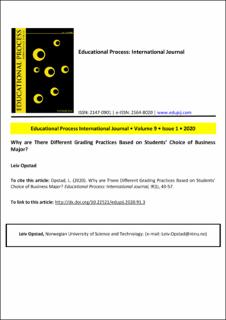| dc.contributor.author | Opstad, Leiv Trygve | |
| dc.date.accessioned | 2020-09-08T12:06:07Z | |
| dc.date.available | 2020-09-08T12:06:07Z | |
| dc.date.created | 2020-05-12T19:09:36Z | |
| dc.date.issued | 2020 | |
| dc.identifier.citation | Educational Process: International Journal. 2020, 9 (1), 43-57. | en_US |
| dc.identifier.issn | 2147-0901 | |
| dc.identifier.uri | https://hdl.handle.net/11250/2676888 | |
| dc.description.abstract | There is a considerable amount of focus on the grading systems applied in higher education, as it is an important tool for ranking undergraduate students’ in terms of their academic success. Several studies have suggested that different grading practices exist among various colleges. This is also the case in Norway, even though the intention is to ensure that the same score is awarded independent of the individual institution. This study will explore the grading practices within a business school in Norway. Since the students can choose different pathways in their third year of undergraduate study, the academic composition of students can vary. Students with good grades mostly prefer Accounting or Finance, whilst those performing below average tend to select Marketing or Management. This composition variance causes differences in the grading pattern, as it is relative easier to achieve a good grade where the peer students are less qualified. This also has a gender effect, since females generally opt to study Marketing or Management, hence the average female student may benefit from a less rigorous grade assessment within these fields. | en_US |
| dc.language.iso | eng | en_US |
| dc.publisher | ÜNİVERSİTEPARK Limited | en_US |
| dc.rights | Navngivelse 4.0 Internasjonal | * |
| dc.rights.uri | http://creativecommons.org/licenses/by/4.0/deed.no | * |
| dc.title | Why are There Different Grading Practices Based on Students’ Choice of Business Major? | en_US |
| dc.type | Peer reviewed | en_US |
| dc.type | Journal article | en_US |
| dc.description.version | publishedVersion | en_US |
| dc.source.pagenumber | 43-57 | en_US |
| dc.source.volume | 9 | en_US |
| dc.source.journal | Educational Process: International Journal | en_US |
| dc.source.issue | 1 | en_US |
| dc.identifier.doi | 10.22521/edupij.2020.91.3 | |
| dc.identifier.cristin | 1810634 | |
| dc.description.localcode | This work is licensed under a Creative Commons Attribution 4.0 International License. | en_US |
| cristin.ispublished | true | |
| cristin.fulltext | original | |
| cristin.qualitycode | 1 | |

